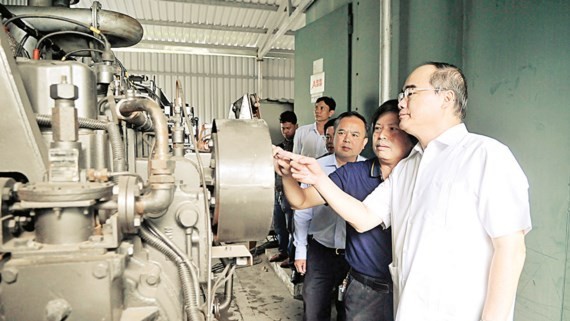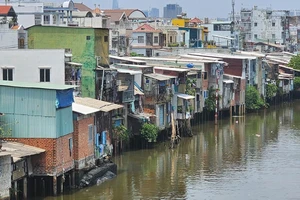
The plant has been built by Hydraulic – Machine Ltd Company (HMC) and HCMC Urban Environment Company.
According to HCMC Urban Environment Company, Go Cat landfill site has stopped receiving household waste since 2007. Buried garbage volume totals 5.3 million tons there.
At the landfill site, there are three projects comprising a transit warehouse of non-toxic industrial waste, a plant treating leaking water from garbage with the capacity of 200 cubic meters a day and Go Cat waste-to-energy plant.
Go Cat landfill site was selected to pilot the waste to energy project because it already has a Dutch financed gas collection system for power generation and a national grid connected system invested by Vietnam Electricity.
The plant started generating electricity and connected to the national grid on April 22 this year. At the end of June, the plant treated 500 tons of industrial waste and generated 7MW of electricity to the national grid.
The Urban Environment Company has sold electricity produced from the plant to HCMC Electricity Corporation at the price of 7.38 cents per kWh. The technology used at the plant is 100 percent made in Vietnam, able to handle solid waste without classification before. That suits the specific characteristics of garbage in Vietnam and differs from other technologies at present.
Still Hydraulic – Machine Ltd Company (HMC) said that the plant’s operation has met with difficulties during the experimental process. Specifically, infrastructure system such as warehouse and gas containers have not been developed synchronously and properly for a waste to energy plant. The gas pipe system invested by the Netherlands is small and unable to meet the plant’s capacity increase.
Estimating the experimental project, Mr. Nguyen Toan Thang, director of the Department of Natural Resources and Environment, said that the project has obtained its initial target of turning industrial waste into electricity. During the operation process, the plant has not polluted the environment.
The city People’s Committee has instructed relevant agencies to establish a scientific council to re-estimate the experimental efficiency of the project to create a basis for investors to establish a project to build household waste treatment plant with the capacity of 1,000 tons a day and submit to the city People’s Committee for approval.
Representatives from Departments of Science and Technology, Planning and Architecture, Construction and Planning and Investment estimated that waste to energy projects will not only improve environmental quality but also help solve a large volume of buried garbage and restore clean land fund for the city.
The remaining matter is that investors should determine plants’ treatment capacity, investment capital and land area to suit the city’s plan, garbage volume and household garbage treatment price list.
Expanding waste to energy plant
Secretary Nguyen Thien Nhan said that HCMC paid much heed to made-in-Vietnam waste treatment technology. The city now receives 1,500 tons of industrial garbage, 300-600 tons of toxic waste and 8,300 tons of household garbage.
Therefore he urged investors: Hydraulic – Machine Ltd Company (HMC) and HCMC Urban Environment Company to develop the Go Cat waste to energy plant with bigger size and capacity.
The former company will operate garbage treatment phase while the later one will arrange garbage supply and develop infrastructure. They should standardize technical norms, determine price list for each type of garbage and diversity technologies to treat household, industrial and toxic waste.
Mr. Nhan urged relevant sides to study treatment of buried garbage, firstly they should experiment on 5.3 million tons of waste at Go Cat landfill site.
He required the Department of Natural Resources and Environment and the Department of Science and Technology to measure air quality during the plant’s operation process, coordinate with the Department of Planning and Architecture to assist investors to broaden the project.
In addition, the city needs to have policies supporting businesses to treat toxic waste and ensure economic development in line with environmental protection.
























